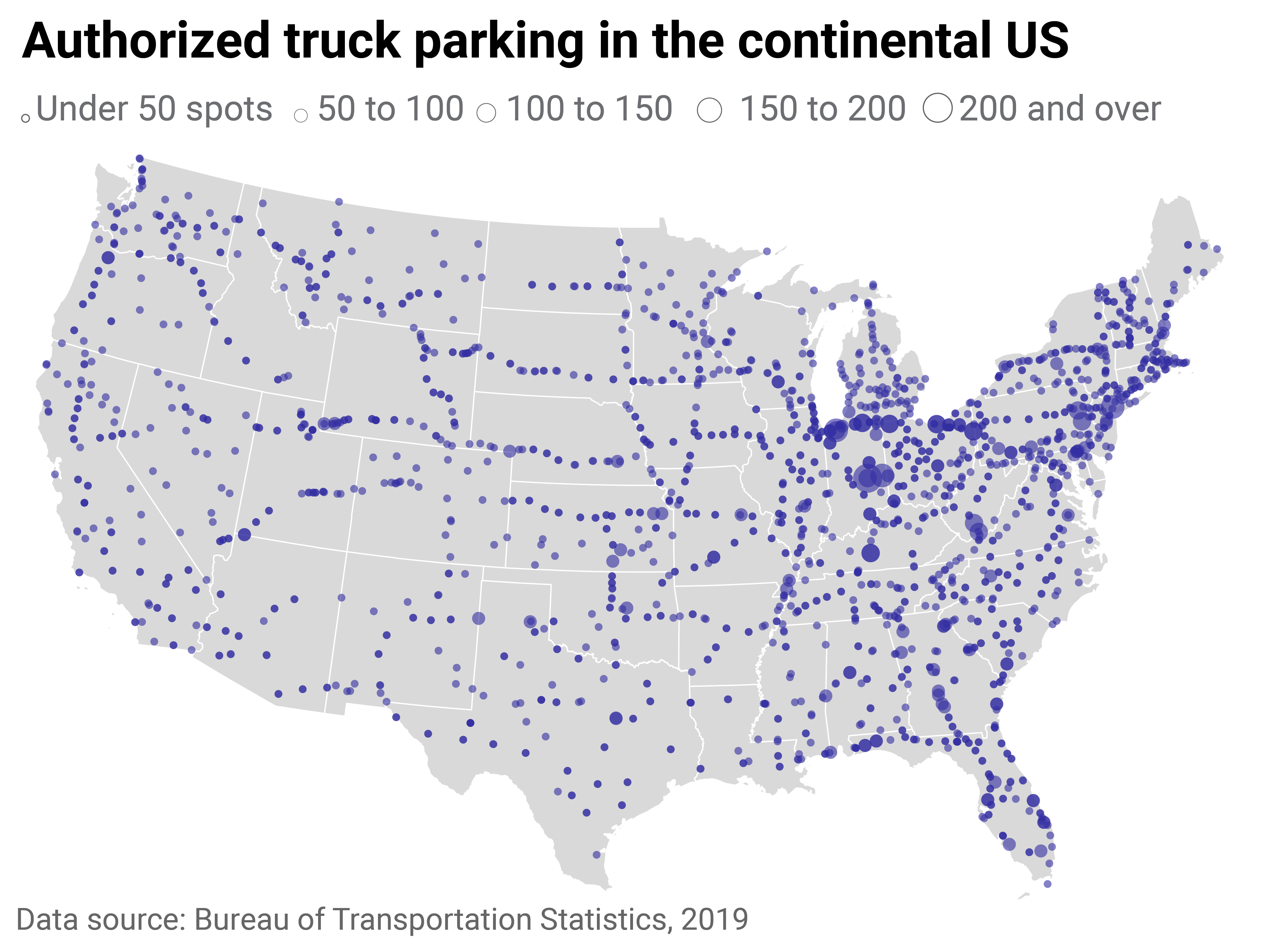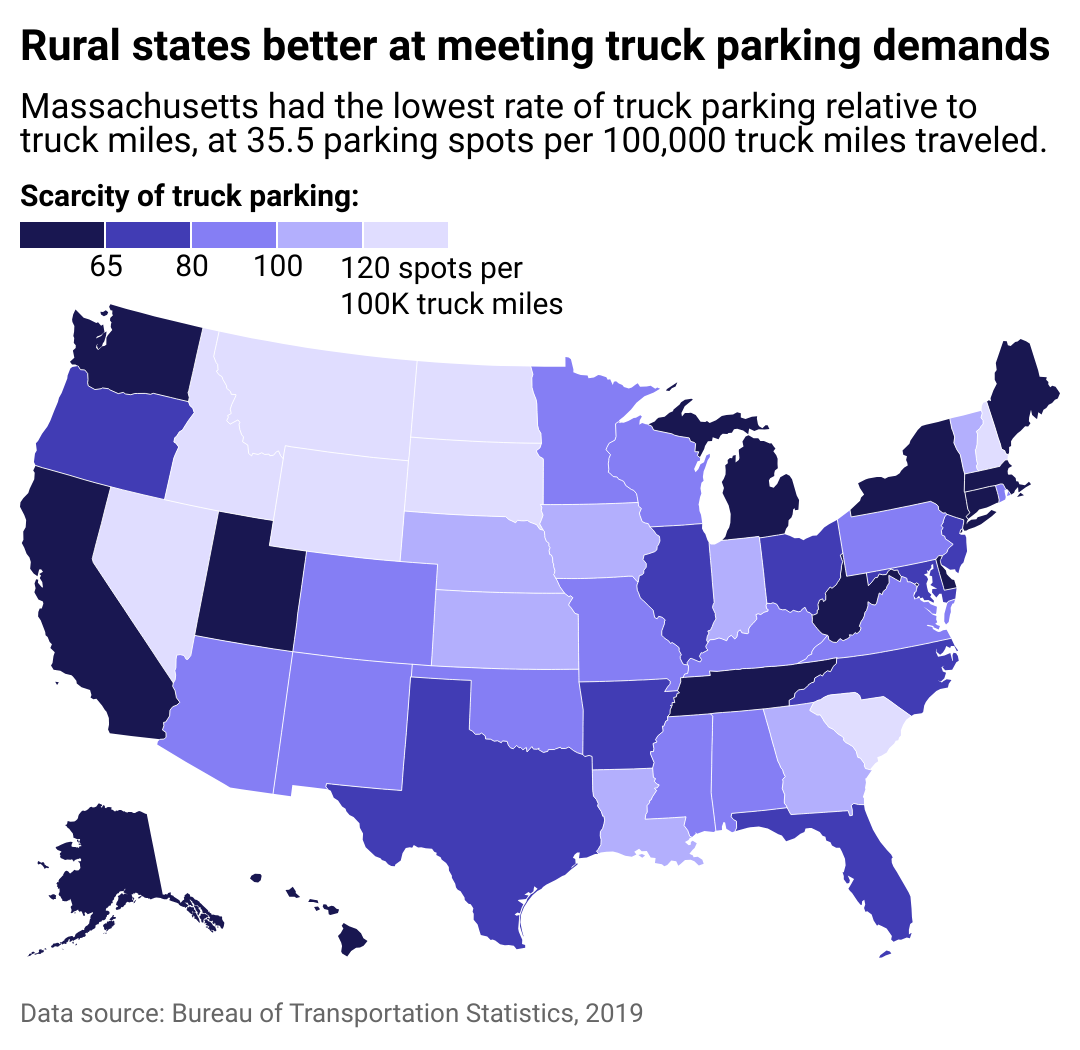
You may have seen them precariously parked alongside highway ramps or clustered in big-box store parking lots. There are millions of big-rig trucks on United States roadways daily, and often, there is nowhere to park them overnight or during mandated driver breaks.
In a Federal Highway Administration survey of more than 11,000 drivers, almost every (98%) driver responded that they have problems finding safe parking, with nearly 3 in 4 drivers reporting it is a regular problem that happens once or more a week. Truck Parking Club used data from the Department of Transportation to explore the severity of the truck parking shortage in the U.S.
Safe, designated semitruck parking facilities often fill up past capacity during overnight hours, leaving drivers to find a makeshift solution—often risking their own safety and that of fellow motorists.
In July 2023, Mario Gonzalez died when his pickup truck crashed into a semitruck parked overnight on the side of a rest stop service road off an interstate near San Antonio. News reports said Gonzalez was speeding and hit the brakes right before impact, and the big-rig did not have its lights on. In another high-profile case that year, a Greyhound bus crashed into three tractor-trailers parked along a ramp's shoulder, killing three passengers in Illinois.
There have also been instances where drivers are pressured to find a spot quickly due to mandatory breaks and time limits, and many say they waste about 56 minutes of available driving time a day looking for parking, according to the American Trucking Association.
In March 2009, a truck driver named Jason Rivenburg needed to drop off his delivery, but the distribution center wasn't open yet, so he had to look for somewhere nearby to park. He chose an abandoned gas station that other truckers had told him was safe. He was attacked and murdered in his sleep, with the murderer taking the $7 that was in his wallet.
Rivenburg's death spurred new legislation called Jason's Law that created a national truck parking survey administered by the DOT. The survey evaluates and measures the capability of each state to provide adequate parking and rest facilities.
An analysis of the survey data by the FHWA found that truck vehicle miles traveled increased by 15% between 2012 and 2017—and parking capacity isn't keeping up. Parking spaces at private facilities increased by 11%, while public spots increased by 6%, according to the FHWA analysis of 2020 data.
While not all trucks are long-haul, and some return to their depots at the end of the day, many truck drivers are forced into the precarious position of searching for parking that isn't there. This data highlights where parking spots are located across the country relative to road coverage, but it doesn't necessarily show where truck drivers most frequently look for parking.

According to the latest Jason's Law national truck parking survey, there are 40,000 parking spots at public rest areas and 273,000 at private truck stops—but that is nowhere near enough.
Nearly 3 in 5 truck drivers admit to parking in unauthorized spots at least three times a week. These can include highway shoulders, ramps, or empty lots.
The ATA estimates that drivers waste precious minutes worth about $5,500 annually in pay as they spend time looking for parking. It's especially hard to find spots near roads connecting major cities in the Southeast, Midwest, and East Coast, as well as along the West Coast and major east-west interstate highways, where truck volume is high, per the DOT.
"I've heard from countless truckers across the country about how the shortage of truck parking costs them time and money—not to mention making our roads less safe and weakening our supply chains," Transportation Secretary Pete Buttigieg told a DOT statement. "We're using funds from President Biden's Bipartisan Infrastructure Law to help address truck parking shortages, and we're working with state and industry leaders to develop more parking that will improve safety and quality of life for our nation's truck drivers."
Additionally, the DOT invested $22.6 million to add about 125 spaces along I-40 near Nashville and $15 million to add about 120 new truck parking spaces along an important roadway between Orlando and Tampa.

The data collected over the years through the Jason's Law survey reveals disparities in parking availability among states.
On the East Coast, Massachusetts and Maine had the lowest available parking with 35.5 spots and 45.3 spots per 100,000 truck miles traveled, respectively, while neighboring New Hampshire and Vermont offered 230 and 109.2 spots. Parking up and down the West Coast is also sparse, with California at 58 spots per 100,000 truck miles traveled, Oregon at 74.2 spots, and Washington at 62.3 spots. Drivers would find more luck in Nevada, with 176.5 spots per 100,000 truck miles traveled, or Idaho, with 147.1 spots. Wyoming was the state with the most spots, with 832.1 spots per 100,000 truck miles traveled.
In some cases, states have applied for and received federal money to help alleviate the problem.
According to the DOT, Caldwell County, Texas, received $22.9 million to construct a trucking park plaza that will include 24-hour monitored security. A Louisiana town is constructing a truck parking facility that will host 50 commercial trucks and include EV charging stations that will ultimately power the trucks' cab heating and cooling, helping curb emissions. Both projects are funded through the Rebuilding American Infrastructure with Sustainability and Equity program and are hailed as examples of President Joe Biden's ongoing commitment to invest in truck parking and roadway safety.
Story editing by Carren Jao. Copy editing by Paris Close.
This story originally appeared on Truck Parking Club and was produced and distributed in partnership with Stacker Studio.